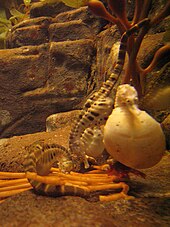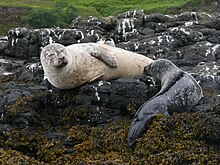Parental care

Swallow adult feeding begging young in the nest
Parental care is a behavioural and evolutionary strategy adopted by some animals, making a parental investment into the evolutionary fitness of their offspring. This strategy involves devoting more effort to a relatively small number of offspring in order to improve offspring reproductive success and the overall fitness of the species; an opposite strategy is to produce a relatively large number of small offspring, often as eggs, and to invest little to no effort into rearing the young.
Although parental care increases the evolutionary fitness of the offspring receiving the care, parental care produces a cost for the parent organism.[1] Energy expended on caring for the offspring and lost mating opportunities are the main costs experienced.[2] Due to the associated costs, parental care will only evolve in a species from a previous condition of no parental care when the costs to the parent associated with providing the care are outweighed by the benefits to the offspring receiving the care.[3]
Parental care is seen in many insects, notably the social insects such as ants, bees and wasps; in certain fishes, such as the mouthbrooders; widely in birds; and especially widely in mammals, which share two major adaptations for care of the young, namely gestation (development of the embryo inside the mother's body) and production of milk.
Contents
1 In groups of animals
1.1 In insects
1.2 In fish
1.3 In birds
1.4 In mammals
1.5 In humans
1.6 In amphibians
2 In evolutionary biology
2.1 Male parental care
3 See also
4 References
In groups of animals
In insects

Potter wasp building mud nest for her offspring. Each nest is provisioned with food caught by the mother; one or more eggs are laid inside, and the nest is then sealed.
Some insects, but especially the Hymenoptera (ants, bees and wasps), invest substantial effort in caring for their young. The type and amount of care varies widely. Solitary wasps such as the potter wasps (Eumeninae) build nests for their young, provisioning them with food, often caterpillars, caught by the mother. The nests are then sealed, and the young live on the food until they leave the nest as adults.[4] In contrast, social wasps and honeybees raise young in substantial colonies, with eggs laid mainly by queens (mothers), and the young cared for mainly by workers (sisters of the young).[5]

Male giant water bug Abedus indentatus with eggs on his back
Outside the Hymenoptera, parental care is found among the burying beetles and the magnificent salt beetle.[6] Subdued forms of parental care are also seen in the Lepidoptera, as in butterflies that lay eggs where the offspring will be able to feed. Crickets have also been known to lay eggs in optimal environments for the young.
Many species of Hemiptera take care of the young. In the Belostomatidae family there are examples of paternal care, for instance in the genus Abedus.
In fish

Pregnant male seahorse
Several different groups of fish have evolved parental care. The young may be guarded by either parent. Some fish such as pipefish, sea dragons and seahorses (Syngnathidae) have a form of male pregnancy, the female taking no part in caring for the young once she has laid her eggs.[7][8] Males in other species may take a role in guarding the eggs before they hatch.
Mouthbrooding is the care given by some groups of fish (and a few other animals such as Darwin's frog) to their offspring by holding them in their mouth for extended periods of time. Mouthbrooding has evolved independently in several different families of fish including the cardinalfish, sea catfish, bagrid catfish, cichlids, snakeheads, jawfishes, gouramis, and arowanas.[9]
In birds
Birds are distinctive in the way they care for their young. In over 90% of birds, both parents help to care for the young. This pattern may have originated in the stem reptiles (archosaurs) that gave rise to the birds, before they developed flight.[10] Most birds, including passerines (perching birds), have their young born blind, naked and helpless (altricial), totally dependent for their survival on parental care. The young are typically raised in a nest; the parents catch food and regurgitate it for the young. Some birds such as pigeons create a "crop milk" which they similarly regurgitate.[11]David Lack developed a hypothesis that clutch size has evolved in response to the costs of parental care known as Lack's principle. It has since seen modifications but is still used as a general model.
In mammals

Harbour seal mother suckling its young
All the higher mammals (excluding the monotremes, namely the echidna and the platypus) share two major adaptations for care of their young, namely gestation (development of the embryo inside the mother's body, followed by live birth) and production of milk. Many mammals exhibit further parental care, including building a nest, digging a burrow, or feeding and guarding their young, often for a prolonged period.[12]
In humans

Parenting is a central aspect of human life, here depicted in a statue in Macedonia.

Human parental care extends far beyond providing food and protection. Here a father teaches his son how to surf.
Parenting or child rearing in humans is the process of promoting and supporting the physical, emotional, social, financial, and intellectual development of a child from infancy to adulthood. This goes far beyond anything found in other animals, including not only the provision of food, shelter, and protection from threats such as predators, but a prolonged period of support during which the child learns whatever is needed to live successfully in human society.[13]
In amphibians
Parental care after the laying of eggs has been observed in 5% of caecilian species, 18% of salamander species and 6% of frog species,[14] though this number is likely an underestimate due to taxonomic bias in research [15] and the cryptic nature of many species.[16] Six modes of parental care are recognized among the Amphibia, in different species: egg attendance, egg transport, tadpole attendance, tadpole transport, tadpole feeding, and internal gestation in the oviduct (viviparity and ovoviviparity).[17] Many species also care for offspring (either eggs or tadpoles) in specially adapted structures of their body. For example, the male pouched frog of eastern Australia protects tadpoles in pouches on the lateral surface of their skin,[18] the gastric-brooding frog raised tadpoles (and potentially eggs) in their stomach[19] and the common Suriname toad raises eggs embedded in the skin on its back.
In evolutionary biology
In evolutionary biology, parental investment is the expenditure of time and effort towards rearing offspring that benefits the offspring's evolutionary fitness at a cost to parents' ability to invest in other components of the species' fitness. Parental care comprises a part of one kind of reproductive strategy in which parents choose to give each of a relatively small number of offspring an increased chance of surviving to reproduce themselves, and may accordingly be accompanied by the production of a small number of zygotes at a time, possibly only one.[20][21]
Male parental care
The evolution of male parental care is particularly rare in non-monogamous species because predominantly, investing effort into mating is more evolutionarily-effective for males than providing parental care.[22][23] One hypothesis regarding the evolution of male parental care in non-monogamous species suggests that parental behavior is correlated with increased siring of offspring.[22] For instance, in mountain gorillas (Gorilla beringei), males of the upper tertile, regarding their frequency of interaction with young gorillas, regardless of the young’s parentage, fathered five times more offspring than males of the lower-two affiliative tertiles.[22] Further, male burying beetles (Nicrophorus vespilloides) attracted three times more females when given the opportunity to breed and provide parental care compared to males that were not presented with a breeding opportunity.[23] Species such as Gorilla beringei and Nicrophorus vespilloides indicate that selection may promote male parental care in non-monogamous species.[22][23]
See also
- Paternal care
References
^ Bednekoff, P. A. (2010). “Life Histories and Predation Risk”. Encyclopedia of Animal Behavior. Academic Press. pp. 285-286. .mw-parser-output cite.citation{font-style:inherit}.mw-parser-output .citation q{quotes:"""""""'""'"}.mw-parser-output .citation .cs1-lock-free a{background:url("//upload.wikimedia.org/wikipedia/commons/thumb/6/65/Lock-green.svg/9px-Lock-green.svg.png")no-repeat;background-position:right .1em center}.mw-parser-output .citation .cs1-lock-limited a,.mw-parser-output .citation .cs1-lock-registration a{background:url("//upload.wikimedia.org/wikipedia/commons/thumb/d/d6/Lock-gray-alt-2.svg/9px-Lock-gray-alt-2.svg.png")no-repeat;background-position:right .1em center}.mw-parser-output .citation .cs1-lock-subscription a{background:url("//upload.wikimedia.org/wikipedia/commons/thumb/a/aa/Lock-red-alt-2.svg/9px-Lock-red-alt-2.svg.png")no-repeat;background-position:right .1em center}.mw-parser-output .cs1-subscription,.mw-parser-output .cs1-registration{color:#555}.mw-parser-output .cs1-subscription span,.mw-parser-output .cs1-registration span{border-bottom:1px dotted;cursor:help}.mw-parser-output .cs1-ws-icon a{background:url("//upload.wikimedia.org/wikipedia/commons/thumb/4/4c/Wikisource-logo.svg/12px-Wikisource-logo.svg.png")no-repeat;background-position:right .1em center}.mw-parser-output code.cs1-code{color:inherit;background:inherit;border:inherit;padding:inherit}.mw-parser-output .cs1-hidden-error{display:none;font-size:100%}.mw-parser-output .cs1-visible-error{font-size:100%}.mw-parser-output .cs1-maint{display:none;color:#33aa33;margin-left:0.3em}.mw-parser-output .cs1-subscription,.mw-parser-output .cs1-registration,.mw-parser-output .cs1-format{font-size:95%}.mw-parser-output .cs1-kern-left,.mw-parser-output .cs1-kern-wl-left{padding-left:0.2em}.mw-parser-output .cs1-kern-right,.mw-parser-output .cs1-kern-wl-right{padding-right:0.2em}
ISBN 978-0-123-72581-3.
^ Fox, R. J.; Head, M. L.; Barber, I. (31 July 2018). “Good Parenting May Not Increase Reproductive Success Under Environmental Extremes”. Journal of Evolutionary Biology. doi:10.1111/jeb.13358.
^ Klug, H.; Bonsall, M. B. (12 May 2014). “What are the benefits of parental care? The importance of parental effects on developmental rate”. Ecology & Evolution. 4 (12): 2330–2351. doi: 10.1002/ece3.1083.
^ Grissell, E. E. (April 2007). "Potter wasps of Florida". University of Florida. Retrieved 12 June 2015.
^ Wong, Janine W. Y.; Meunier, Joel; Molliker, Mathias (2013). "The evolution of parental care in insects: the roles of ecology, life history and the social environment". Ecological Entomology. 38 (2): 123–137. doi:10.1111/een.12000.
^ Susan Allport (1 April 2003). A Natural History of Parenting: A Naturalist Looks at Parenting in the Animal World and Ours. iUniverse. pp. 19–20. ISBN 978-0-595-27130-6.
^ Wilson, A. B.; Orr, J.W. (2011). "The evolutionary origins of Syngnathidae: pipefishes and seahorses". Journal of Fish Biology. 78 (6): 1603–1623. doi:10.1111/j.1095-8649.2011.02988.x. PMID 21651519.
^ Wilson, A. B.; Ahnesjo, I.; Vincent, A.; Meyer, A. (2003). "The dynamics of male brooding, mating patterns, and sex roles in pipefishes and seahorses (family syngnathidae)". Evolution. 57 (6): 1374–1386. doi:10.1111/j.0014-3820.2003.tb00345.x. PMID 12894945.
^ Helfman, G., Collette, B, Facey, D. (1997). The Diversity of Fishes. Blackwell. ISBN 978-0-86542-256-8.CS1 maint: Multiple names: authors list (link)
^ Wesolowski, Tomasz (2004). "The origin of parental care in birds: a reassessment". Behavioral Ecology. 15 (3): 520–523. doi:10.1093/beheco/arh039.
^ Ehrlich, Paul R.; Dobkin, David S.; Wheye, Darryl (1988). "Parental Care". Stanford University. Retrieved 15 January 2016.
^ David J. Gubernick (11 November 2013). Parental Care in Mammals. Springer Science & Business Media. ISBN 978-1-4613-3150-6.
^ Davies, Martin (2000). The Blackwell encyclopedia of social work. Wiley-Blackwell. p. 245. ISBN 978-0-631-21451-9.
^ Crump, Martha L (1996). Parental care among the Amphibia. Advances in the Study of Behavior. 25. pp. 109–144. doi:10.1016/S0065-3454(08)60331-9. ISBN 9780120045259.
^ Stahlschmidt, Zachary R (2011). "Taxonomic Chauvinism Revisited: Insight from Parental Care Research". PLOS One. 6(8): e24192 (8): e24192. doi:10.1371/journal.pone.0024192. PMC 3164163. PMID 21904614.
^ Oneto, Fabrizio; Ottonello, Dario; Pastorino, Mauro Valerio; Salvidio, Sebastiano (December 2010). "Posthatching Parental Care in Salamanders Revealed by Infrared Video Surveillance". Journal of Herpetology. 44 (4): 649–653. doi:10.1670/09-181.1. JSTOR 40983661.
^ Crump, Martha L (1996). Parental care among the Amphibia. Advances in the Study of Behavior. 25. pp. 109–144. doi:10.1016/S0065-3454(08)60331-9. ISBN 9780120045259.
^ Anstis, Marion (2013). Tadpoles and Frogs of Australia. Sydney: New Holland Publishers. pp. 526–531. ISBN 9781921517167.
^ Anstis, Marion (2013). Tadpoles and Frogs of Australia. Sydney: New Holland Publishers. pp. 668–673. ISBN 9781921517167.
^ Gilbert, James (30 September 2013). "Evolution of Parental Care". Oxford Bibliographies. Retrieved 15 January 2016.
^ Gilbert, James (23 May 2012). "Reproductive Allocation in Animals". Oxford Bibliographies. Retrieved 15 January 2016.
^ abcd Rosenbaum, S.; Vigilant, L.; Kuzawa, C.; Stoinski, T. (15 October 2018). “Caring for infants is associated with increased reproductive success for male mountain gorillas”. Scientific Reports. 8: 15223. doi:10.1038/s41598-018-33380-4.
^ abc Chemnitz, J.; Bagrii, N.; Ayasse, M.; Steiger S. (01 February 2017). “Staying with the young enhances the fathers’ attractiveness in burying beetles”. Evolution. 71 (4): 985-994. doi:10.1111/evo.13194.
